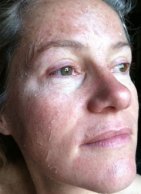Last month I began a physician-strength PCA chemical peel with Dr. Macdonald for my face, neck and chest (a.k.a. decolletage area) to attempt to repair some –if not all–of my sun-damaged skin. Now I am on peel #3 of 5 and seeing a positive effect. Dr. Macdonald, whom I only see every 2 weeks, sees a noticeable difference as well.
 On peel #2, the concentration was increased on both the neck and chest to PCA resorcinol which contains hydroquinone to lighten the hyperpigmentation. On peel #3, resorcinol was used on my face too, and yet a stronger dose on chest and neck since I had very little reaction on previous attempts.
On peel #2, the concentration was increased on both the neck and chest to PCA resorcinol which contains hydroquinone to lighten the hyperpigmentation. On peel #3, resorcinol was used on my face too, and yet a stronger dose on chest and neck since I had very little reaction on previous attempts.
The resorcinol peel does produce a hot, burning sensation during the peel, making it soothing to use the fan to cool my skin for 10 minutes.
Rosacea. An issue Dr. Macdonald wanted to bring to my attention is some rosacea on my cheeks and nose (i.e., little red blood vessels on the skin). After lightening my hyperpigmentation, the red vessels will be more visible. His solution would be to treat the rosacea with laser treatment after the peels are completed with VariLite laser at 512 nm strength.
Like clockwork, it seems that after 48 hours, my skin begins to peel and lasts until around day 6 for the face, with a longer delay on the neck.
My neck has been the itchiest. I treated this with hydrocortisone creams. PCA SKIN® Après Peel Soothing Balm (with 0.5% hydrocortisone) was especially supportive. I also fell in love with a new lotion with a soothing effect called “Yes to™ Cucumbers” It is formulated for sensitive skin and gently hydrates with organic cucumbers, aloe vera and green tea.
During one of my peely-ist moments, an acquaintance asked me: Is that good for you? Answer: Here is exactly what happens to the skin–and underneath the skin–during the 2 weeks between peels.
The carefully selected solutions in a chemical peel sink into the skin and cause the skin layers below the surface to react on the cellular level.
- The skin cells are repaired
- Melanin is reduced (darkness)
- Cells produce more collagen and elastin
- Dead cells are eaten away
Even though it looks like a sunburn, there is a science behind chemical peels vs. the sun. Melanin protects the skin from the sun’s harmful rays or from any skin injury.
- Suntan. The skin of a person with enough melanin in their skin to handle the sun’s rays turns a little darker as a result.
- Brown spots. However, the skin of a person with less melanin in their skin reacts; it goes into protection-mode and releases melanin (that naturally lays beneath the skin’s surface). This melanin rises to the surface… but not uniformly, resulting in a spotty look.
The tender skin on my neck and chest are starting to react for the first time on peel #3. Of course, I have the itchiness but also some significant skin shedding….
Throughout the peel process, I need to pay extra attention to sunscreen. During the days where I’m wearing lots of lotions to sooth or cover up peeling and itching, it sure is nice to have the powdered sunscreen by Colorscience®. [Dr. Macdonald is now carrying this product in his office.]
5-minute sauna and steamroom steam sessions sure do help to break down and soften harder, thicker, dryer skin on days 4-5, while continually dousing with cool water while in the steam.
 I’ve experienced the most advanced stage of peeling today (counting my PCA peel last year, 1st and 2nd PCA peels this past month and Vi PEEL™ this year) on day 5 of peel #3. I’m scared to post this one, but here is a lovely photo of my peeling-look as I woke up this morning. Today is the day I discovered the “Yes to™ Cucumbers Soothing Cooling Body Butter“. In a few days I will be all better…
I’ve experienced the most advanced stage of peeling today (counting my PCA peel last year, 1st and 2nd PCA peels this past month and Vi PEEL™ this year) on day 5 of peel #3. I’m scared to post this one, but here is a lovely photo of my peeling-look as I woke up this morning. Today is the day I discovered the “Yes to™ Cucumbers Soothing Cooling Body Butter“. In a few days I will be all better…
Dr. Macdonald has a full-fledged skin rejuvenation and skincare treatment center in his office, including laser treatments for full fractional resurfacing, skin tightening, sun damage repair to hair removal, dark spots and rosacea.
Pam DePianto is his new Medical Esthetician in the office as of August. Pam is focusing exclusively on the beauty of your skin… She brings you 15+ years of experience as a small skin spa owner, a Kaiser skin health educator and, most recently, the lead esthetician for an East Bay dermatology & plastic surgery practice. With Pam, you’ll be in good hands!
Pam is offering a special Pumpkin Enzyme Peel Facial now (on special now through next Friday):
This luxurious facial is loaded with antioxidants, beta-carotene and vitamin C to replenish the skin with much needed nutrients. Exfoliating the skin’s surface, this facial will soften the appearance of fine lines and wrinkles as it improves the skin’s texture. Price includes: deep cleansing, steam, pumpkin enzyme exfoliation, extractions, massage, treatment mask, treatment serums, day cream and SPF.
© 2011 R.E.L. Copywriting. All rights reserved.


You must be logged in to post a comment.